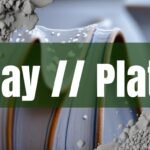Crafting a plate from clay is a deeply rewarding experience, connecting you to a tradition that spans millennia. Whether you’re drawn to the meditative rhythm of the pottery wheel or the tactile satisfaction of hand-building, the journey from a lump of earth to a functional piece of art is filled with creative potential. This guide will walk you through the essential steps, from selecting the right clay to applying the final glaze, ensuring your success in creating beautiful and durable pottery plates.
Gathering Tools and Materials
First, you’ll need to gather your tools and materials. The most important choice is the clay itself. Earthenware clay is a popular choice due to its versatility and the warm, rich colors it achieves at lower firing temperatures, typically between 950°C and 1,100°C (1,745°F and 2,012°F). It’s known for its porosity, which means it will need a good glaze to be food-safe. Stoneware, on the other hand, fires at higher temperatures, between 1000°C and 1380°C, resulting in a stone-like, durable, and non-porous piece ideal for holding liquids and foodstuffs. Many stoneware clays are suitable for functional ware if they have a low water absorption rate, ideally less than 3%. Porcelain, often known as kaolin, is another option, prized for its whiteness and translucency. It fires at very high temperatures and becomes non-porous and very hard. Other clays include ball clay, which is known for its plasticity and is often used in blends, and fire clay, which is pure and has an extremely high firing range. For more information on different types of clay, see this comprehensive guide.
In addition to clay, you’ll need a pottery wheel if you plan to throw your plate, or hand-building tools like rolling pins, wooden paddles, and wire clay cutters if you prefer to build by hand. Other essential tools include ribs for shaping, sponges for smoothing, wire cutters for removing your piece from the wheel, and trimming tools for refining the form. For those interested in hand-building, exploring sprigging techniques can add unique decorative elements to your plates.
Creating Your Plate
The journey of creating a plate begins with centering the clay on the wheel. This is a crucial step that requires patience and practice. Start with a ball of clay appropriate for the size of plate you want to make. Throw it firmly onto the center of the wheel head. With the wheel spinning at a medium speed, use your hands to cone the clay up and then push it back down, repeating this process until the clay is stable and centered. Once centered, gently open the clay by pressing your thumbs into the center, creating a well. Then, widen the base of the plate by carefully pressing outwards from the center, keeping the base flat and even. Next, begin raising the walls of the plate. Use your fingers to compress and lift the clay, working from the base upwards. The goal is to create a shallow, even wall that will form the plate’s rim. Pay close attention to maintaining a consistent thickness to prevent weak spots or warping during firing. For hand-building a plate, you can use pinch pot, coil building, or slab construction techniques. Pinch pots involve creating a small bowl by pinching the clay between your fingers and then flattening it into a plate shape. Coil building involves rolling out coils of clay and layering them to create the plate’s walls, while slab construction involves rolling out flat slabs of clay and joining them together.
Once the basic shape is formed, it’s time to refine the plate. If wheel-throwing, use trimming tools to remove excess clay from the bottom and create a foot ring. The foot ring provides stability and elevates the plate slightly. Trimming should be done when the clay is leather-hard, meaning it’s firm enough to hold its shape but still soft enough to be worked. If hand-building, refine the shape by smoothing out any unevenness and ensuring the walls are consistent. Next, the plate needs to dry slowly and evenly to prevent cracking. This can take a week or more. Wrap the plate loosely in plastic to control the drying process, and dry it on a wire rack or pegboard to allow airflow. To prevent the rim from drying faster than the center, you can cut a hole in the plastic wrap over the center of the plate. Once the plate is bone dry, it’s ready for bisque firing. This initial firing hardens the clay and makes it easier to handle during glazing.
Glazing and Firing
Glazing is a crucial step that adds color, texture, and functionality to your pottery plate. There are many glazing techniques to choose from, each offering a unique aesthetic. Dipping involves immersing the entire plate in a glaze, resulting in a smooth, even coating, provided the glaze is finely sieved. Brushing is another common technique, ideal for applying multiple layers or creating intricate designs. Spraying is useful for applying a base layer or creating gradient effects, while splattering, stippling, and sponging can be used to create interesting textures. Glaze trailing involves applying glaze in lines to create natural and abstract designs, and wax resist can be used to protect certain areas from glaze. Consider fantastic glaze combinations,One brushed coat each (in order): 405 Daiquiri Freeze, 418 Liquid Smoke and 442 Emerald. Or Detail of bowl dipped in PC-25 with a thick PC-53 trailed around the rim. Once the glaze is applied, the plate is ready for its final glaze firing. The firing temperature will depend on the type of clay and glaze you’re using, so it’s important to follow the manufacturer’s instructions.
Achieving success in pottery plate making requires patience, attention to detail, and a willingness to learn from mistakes. One common problem is cracking, which can be caused by uneven drying. To prevent this, dry the plate slowly and evenly, and avoid drafts. Warping is another issue, often caused by uneven thickness or firing temperatures. Make sure the plate is evenly thick and avoid placing it too close to the elements in the kiln. Notching the foot rings can help with warping, cracking, and s-cracks, as the notches allow air to escape. Glaze defects can occur due to improper application or firing temperatures. Always follow the manufacturer’s instructions for your glaze, and ensure your kiln is properly calibrated.





